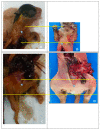Pentalogy of Cantrell in Two Neonate Littermate Puppies: A Spontaneous Animal Model Suggesting Familial Inheritance
- PMID: 37443889
- PMCID: PMC10339899
- DOI: 10.3390/ani13132091
Pentalogy of Cantrell in Two Neonate Littermate Puppies: A Spontaneous Animal Model Suggesting Familial Inheritance
Abstract
Developmental anomalies are an important cause of stillbirth and early perinatal death in companion animals. Many of these disorders remain poorly understood and provide an opportunity as a spontaneous animal model for human disease. Pentalogy of Cantrell is a rare congenital syndrome described in human neonates. It is a ventral midline closure defect with a proposed familial inheritance in humans. This syndrome involves five defects, including the thoracoabdominal wall, sternal, diaphragmatic, pericardial and cardiac malformations. Diverse expressions of these defects have been described in humans and sporadically in domestic animals. This severe syndrome commonly harbors a poor prognosis, posing an ethical and surgical dilemma. To better understand this syndrome and its presentation in dogs, we describe two rare cases of Pentalogy of Cantrell in a litter of papillon dogs. The affected puppies had anomalies compatible with the Pentalogy of Cantrell, including thoracoabdominal schisis, ectopia cordis, sternal cleft, pericardial agenesis, and diaphragmatic defects. The diagnosis was confirmed by advanced imaging (computed tomography) and postmortem examinations. The family history of this litter was explored and other cases in domestic animals were reviewed. This is the first report of the complete Pentalogy of Cantrell with ectopia cordis in the dog and the only report on papillons. Similar to human cases, possible familial inheritance and suspected male gender bias were observed. Further research on this novel animal model, its pathogenesis and its hereditary basis, may be helpful in better understanding this rare developmental disorder.
Keywords: canine; congenital; ectopia cordis; gastroschisis; midline closure defect; papillon; rare disease; thoracoabdominal syndrome.
Conflict of interest statement
The authors declare no conflict of interest. The funders had no role in the design of the study; in the collection, analysis, or interpretation of data; in the writing of the manuscript; or in the decision to publish the results.
Figures


Similar articles
-
Cardiac anomalies in Cantrell's pentalogy: From ventricular diverticulum to complete thoracic ectopia cordis.Cardiol Tunis. 2013;9(1):94-97. Cardiol Tunis. 2013. PMID: 25541632 Free PMC article.
-
Radiological findings of partial expression pentalogy of Cantrell and other multiple congenital anomalies: A rare case report.Radiol Case Rep. 2022 Jun 28;17(9):3172-3178. doi: 10.1016/j.radcr.2022.05.083. eCollection 2022 Sep. Radiol Case Rep. 2022. PMID: 35801122 Free PMC article.
-
The pentalogy of Cantrell: A rare and challenging prenatal diagnosis.Int J Surg Case Rep. 2023 Nov;112:108941. doi: 10.1016/j.ijscr.2023.108941. Epub 2023 Oct 10. Int J Surg Case Rep. 2023. PMID: 37879290 Free PMC article.
-
Pentalogy of Cantrell.Semin Pediatr Surg. 2019 Apr;28(2):106-110. doi: 10.1053/j.sempedsurg.2019.04.006. Epub 2019 Apr 9. Semin Pediatr Surg. 2019. PMID: 31072457 Free PMC article. Review.
-
Co-occurrence of severe Goltz-Gorlin syndrome and pentalogy of Cantrell - Case report and review of the literature.Am J Med Genet A. 2011 May;155A(5):1102-5. doi: 10.1002/ajmg.a.33895. Epub 2011 Apr 11. Am J Med Genet A. 2011. PMID: 21484999 Review.
Cited by
-
Complete Thoracic Ectopia Cordis in Two Lambs.Animals (Basel). 2024 Jul 30;14(15):2213. doi: 10.3390/ani14152213. Animals (Basel). 2024. PMID: 39123739 Free PMC article.
References
-
- Gill M.A. Ph. D. Thesis. University of Sydney; Sydney, Australia: 2001. [(accessed on 5 May 2023)]. Perinatal and Late Neonatal Mortality in the Dog. Available online: http://hdl.handle.net/2123/4137.
-
- Mazrier H., French A., Ellinwood N.M., van Hoeven M., Zwiegle J., O’Donnell P., Jezyk P.F., Haskins M.E. Goitrous congenital hypothyroidism caused by thyroid peroxidase deficiency in a family of domestic shorthair cats. J. Vet. Intern. Med. 2003;17:395–396.
Publication types
Grants and funding
LinkOut - more resources
Full Text Sources

